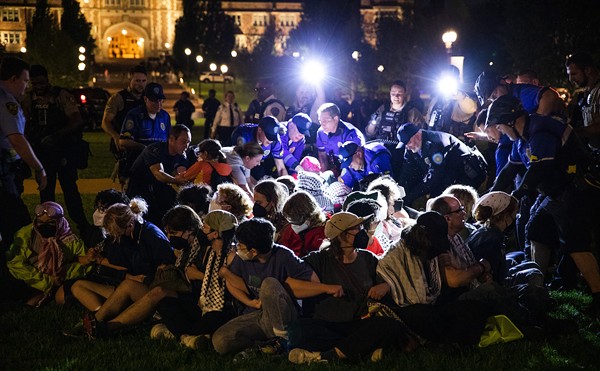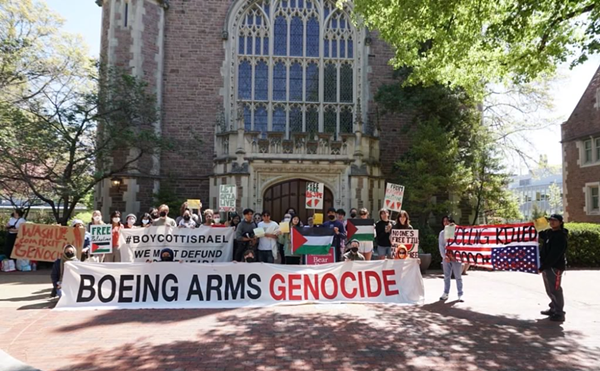Unreal: How many members are there?
Chris Harrison: At this point, it's just me. I haven't figured out how to recruit, I guess is my problem. I tried a couple fliers one time and all I got was hostile hate mail from people who think that all gays are going to Hell.
Why the lack of interest?
I think a lot of people, and St. Louis is especially bad — and I don't know if "bad" is the right word — but people think people who own guns are the toothless redneck sort of person, and obviously that's not true, especially in the gay community.
So what kind of heat are you packing?
I have a shotgun for trap shooting, a shotgun for hunting birds, a deer rifle, a little .22 rifle for target shooting and a couple of handguns. I can carry a handgun but I very rarely do.
Are the pistols actually pink?
No. I think there was a company making pink and orange brightly colored pistols, but I don't think they actually are anymore. The idea of guns that look like toys seems like a bad idea to me.
So when you're at the shooting range, do you ever picture someone's face on the target?
No, I don't. I spent seven years in the Army and I've been shot at on three continents. I rather hope to never have to shoot an actual person ever again. So as a general rule I don't use human silhouette targets and I don't put human faces on them. My ex-wife is not on the target.
What's the biggest and/or coolest gun you've ever fired?
Well, I spent seven years in the Army like I said, so a .50 caliber machine gun is probably biggest thing I've ever shot.
Bill O'Reilly did a story about the Pink Pistols describing them as a "vicious pink pistol-packing lesbian gang." What would say to Bill if you saw him in person?
If I encountered Bill O'Reilly in person, I don't think I would be able to speak to him because my mother taught me if you don't have anything nice to say, don't say anything at all. Correction published 10/18/07: As originally published, the Unreal item about the Pink Pistols characterized the group as a gay gun-rights group. As the Pistols point out on their own Web site, www.pinkpistols.org, they're open to one and all. The above version reflects this correction. (In the interest of full disclosure, it also reflects the correction of a misplaced modifier that we couldn't resist fixing.)
Bud Out!
The following is an Unreal editorial and does not reflect the views and opinions of Riverfront Times:
First they came for Spykes (those fruity, malt-beverage shots enjoyed by high school girls nationwide), and no one — except Unreal — said anything. Now they're coming for Bud Extra and you know they won't stop there. Earlier this year, attorneys general representing 28 states banded together to demand that Anheuser-Busch pull Spykes from the market. They won that battle, and now the same bureaucratic party-poopers are requesting that the brewer halt production of Bud Extra — its refreshing and reviving caffeinated beer.
While constituents in other states might tolerate such government interference, we here at Unreal find such prohibitionist rhetoric as unpalatable as a can of Old Style. Kudos to Missouri Attorney General Jay Nixon for conspicuously not lending his name to the letter his colleagues sent the Alcohol and Tobacco Tax and Trade Bureau urging that Bud Extra be sanctioned.
Nixon knows where his bread is buttered. More specifically, he knows where his beer is brewed and, in the case of Bud Extra, infused with caffeine, ginseng and guarana. "Combining alcohol with caffeine hardly seems healthy — and that false claim is what we seek to halt," says Connecticut Attorney General Richard Blumenthal, one of the state lawyers leading the charge against Bud Extra.
Obviously, Blumenthal and his fellow teetotalers don't know the first thing about mixing stimulants with booze. This time-honored craft spans the generations. Why, one need not look any further than those black-and-white movies of the 1950s for evidence. Any time a character in those films has too much to drink, the first thing you see is a bartender pour the person a coffee. Why? Because caffeine was thought to act as a sobering agent. Of course, we now know that the only thing caffeine does when mixed with alcohol is to create wide-awake drunks. But is that so bad? Who wants to fall asleep at the proverbial wheel? (Just ask Tony La Russa)
Contrary to Mr. Blumenthal's statement, alcohol and caffeine is healthy, especially for anyone with a healthy appetite for partying! That's why Unreal will not tolerate another senseless attack on A-B and its tasty — if not questionable — libations. After all, if the AGs win this battle, what's next? A ban on Bud Light because it doesn't actually promote weight loss?
Sign of Christ
For the past 25 years, University City photographer Sam Fentress has been hunting down religious messages on America's highways and byways and taking pictures of them. He's just published the findings in his new book, Bible Road: Signs of Faith in the American Landscape. Unreal caught up with Fentress while he was, appropriately, on the road.
Unreal: So do you see any signs right now?
Sam Fentress: Actually, I just drove past one on Highway 57 near Mount Vernon that says "Hell is hot."
How do you find these signs?
Sometimes randomly, when I'm looking for other things. When people found out what I was doing, they'd tell me when they found something. But a lot of times they'd disappear by the time I'd get there.
What do you regret missing?
Once I had directions to a sign in Pennsylvania. It was supposed to have a mushroom cloud juxtaposed with a message about the beginning of end times. That one precipitated a fight. I went to check it out with my family in tow — all eight of us. It was a detour on a trip to Massachusetts. The kids were hungry and tired and crabby. I told my wife I just had one more lead to follow. And we got there, and it wasn't there. I really regret missing that one.
Which one is your favorite?
The one in Suitland, Maryland — of Christ Did It All Beauty Salon. I took a lot of shots, but this one is my favorite: It's a close-up — it's more mysterious, the layering of it, the glass, the metal security blinds. The glass says "Matthew 6:33." It refers to the quote from the Sermon on the Mount about not worrying what you wear or eat. It's like they're advertising against their own product.
Which denominations do the best signs?
I see more Protestant than Catholic. It's rare to see something put up by an Episcopalian. You see a lot more by Pentecostals and Baptists. I don't see a lot of Jewish or Islamic signs in the U.S.
Do you think there's potential for a sequel, like Torah or Koran or Bhagavad Gita Road?
I'll leave that to somebody else. I'm ready to move on to the next thing. I've seen "Trust Jesus" on highway pylons so many times, it would have to be extraordinary for me to stop and look at it.
Callous Indifference
This year marks the 50th anniversary of the publication of On the Road, Jack Kerouac's paean to the splendor of road-tripping across the U.S.A. You'd think that a book that crisscrosses the country from New York to San Francisco might contain some mention of our fair city; we are, after all, the Gateway to the West.
But apparently not for Kerouac's alter ego, Sal Paradise. He first crosses his beloved Mississippi River — in Davenport, Iowa. Oh, the indignity!
We do get a couple of brief mentions later on, though, as Sal starts heading home: "We arrived in St. Louis at noon. I took a walk by the Mississippi River and watched the logs that came floating from Montana in the north — grand Odyssean logs of our continental dream. Old steamboats with their scrollwork more scrolled and withered by weather sat in the mud inhabited by rats." And later: "The muddy cobbles, the broken steamboats, the ancient signs, the grass and the ropes by the river. The endless poem."
Harumph. Frankly, we expected a little more than a few images of decay. Kerouac himself once said that St. Louis was the birthplace of Beat — or at least William S. Burroughs and Lucien Carr did, which is pretty much the same thing, isn't it? Why the indifference?
We decided to look into it and learned that Kerouac had suffered from phlebitis (inflamed veins in the leg) since his days in the Navy during World War II, and that he had a particularly nasty flare-up as he passed through St. Louis aboard a Greyhound in the fall of 1947. In between all the necking with his near-sighted seatmate (which did make it into the book), he spent the rest of the ride trying to massage the pain away. Hardly romantic and hardly worthy of his image as the intrepid adventurer, but possibly just enough to taint his memory of our city forever.





